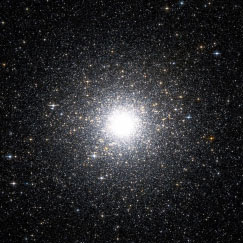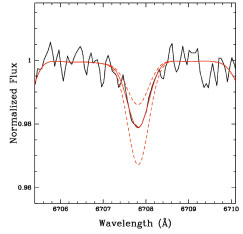Lithium (together with hydrogen and helim) is one of the few elements created just after the « Big Bang » during the Universe’s famous first three minutes.
A challenge for cosmology
The determination ion of the primordial lithium abundance in the oldest stars provides a crucial test of the « Big Bang ». It is thought that the oldest stars carry a record of the abundances rsulting from the primoridal nucleosynthesis which took place during the first minutes of the Big Bang.
However, measurements in dwarf stars in the galactic halo, the oldest stars in the Milky Way, are not in agreement with the abundance of lithium as predicted by cosmological models. This disagreement constitutes a deep astrophysical enigma.
Until now, measurements have been limited to just the close stars within our own galaxy, no farther than 35 000 light years from the Sun.
It was thus not possible to ascertain whether this disagreement in the lithium abundance between observation and prediction was just a feature of our own galaxy or was also present in stars from other galaxies. Or, in other words, to know whether the oldest stars were all created with the same lithium abundance - as predicted by the by the various cosmological models.
The most distant measurement ever made


One can thus better appreciate the importance of this result. The international team, led by Alessio Mucciarelli (Bologna University, Italy), which includes Piercarlo Bonifacio, CNRS research director in the « Galxies, stars, physics and instruments » department (département Galaxies, étoiles, physique et instrumentation - GEPI) of the Paris Observatory has just carried out the farthest determination of lithium abundance in old stars. It has obtained a very high resolution spectrum of giant stars in the extragalactic globular cluster M54, a group of massive stars in the dwarf Saggitarius spheroidal galaxy, about 100 00 light years away.
The observations were made using the Giraffe spectrograph, built at the GEPI and installed since 2002 at ESO’s Very Large Telescope.

This work is based on a very new method for measuring the abundance of lithium in stellar systems, till now applied to the observation of dwarf stars, and adapted here for giant stars.
A universal problem
With this first ever study of the amount o flithium in the giant stars within the extragalactic globular cluster M54, scientists have taken another step in the quest to unravel the mystery of the missing lithium.
The theory of stellar evolution enables one to link the abundance of lithium in the giant stars which were observed, with that in the old dwarf stars in the same cluster. And it turns out that the lithium abundance observed in M54 is identical to that found in the old dwarf stars within our own galaxy.
This discovery shows that the old stars, wherever they are, would seem to have been born with one and the same inital lithium abundance.
And so the difference which has been noted between observation and prediction has become a universal problem, and not just one limited to the Milky Way. This information must now be taken into account, and will constitute a constraint in theories related to the problem of the missing lithium.
Source
The cosmological Lithium problem outside the Galaxy : the Sagittarius globular cluster M54, by A. Mucciarelli et al., to appear in Monthly Notices of the Royal Astronomical Society (Oxford University Press).
